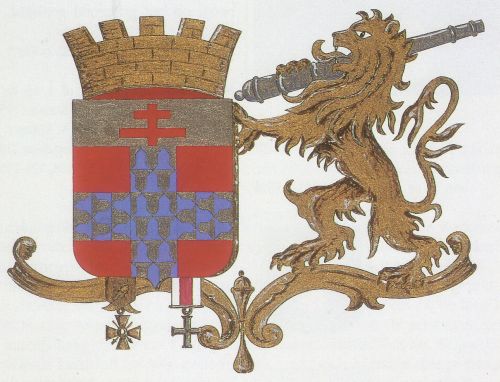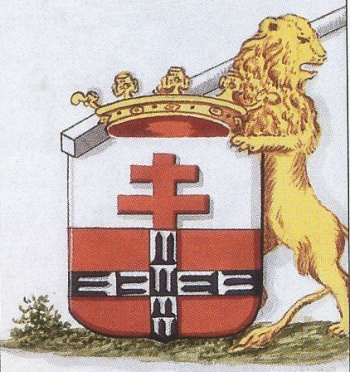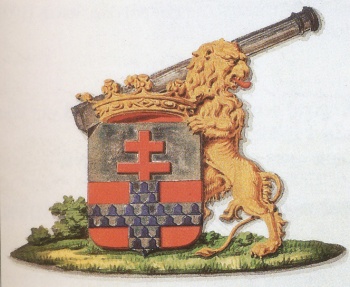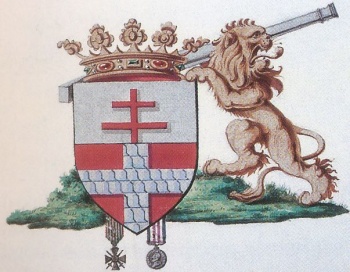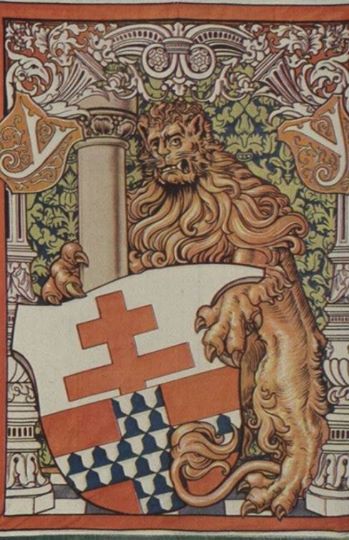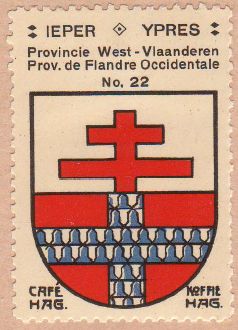Ieper
| Heraldry of the World Civic heraldry of Belgium - Belgische Gemeentewapens / Armorial de Belgique |
IEPER
Province : West-Vlaanderen
Additions : 1970 Brielen, Sint Jan; 1976 Boezinge (1970 Zuidschote), Dikkebus, Elverdinge, Vlamertinge, Zillebeke (1970 Hollebeke, Voormezele)
Official blazon
- (1819) Dwars door midden gedeeld, waarvan het eerste van zilver beladen met een patriarchaal rood kruis, het tweede van rood beladen met een gevaireerd kruis, het schild gedekt met een gouden kroon en ter linkerzijde vastgehouden door een klimmenden gouden leeuw dragende in deszelfs voorste regter poot een zilveren kolom.
- (1844) Een zilveren schild gesteld op een rood veld, het eerste deel beladen met een rood patriarchael kruis, en het tweede met een wit en blauw kruis, het schild gedekt met eene gulden kroon, rustende ter linker zijde op eenen gulden leeuw, dragende op de regter schouder eene zilveren zuil.
- (1925) Doorsneden: in 1 van zilver met een aartsvaderlijk kruis van keel, in 2 van keel met een kruis van vair. Het schild overtopt met eene kroon met vijf bladeren van goud, gehouden links door een omzienden leeuw van hetzelfde eene schuinsliggende zuil van zilver op de rechterschouder dragende uiterlijk versierd met de juweelen van het fransch oorlogskruis en de engelsche militaire medaille vergezeld van hun lint van den schildvoet uitgaande.
- (1988) In keel een kruis van vair en een schildhoofd van zilver, beladen met een patriarchaal kruis van keel. Het schild getopt met een muurkroon met vijf kantelen van goud en gehouden links door een leeuw van hetzelfde, dragende op de rechterschouder een kanonloop van zilver. Twee juwelen, hangende aan hun lint, uitgaande van de schildvoet, rechts het Franse Oorlogskruis, links het Engelse Militaire Kruis.
Origin/meaning
The arms were granted on October 20, 1819, confirmed on February 26, 1844, changed and confirmed on March 31, 1925 and again on March 1, 1988.
| The arms from 1819 |
The arms from 1844 |
| The arms from 1925 |
The double cross is the oldest symbol of the city of Ieper. The oldest use of the cross dates from a seal of the city from 1199. On the oldest seal the cross is surrounded by two eagles, a star and crescent as well as two lions of Vlaanderen.
The present arms, with a second cross of vair in the lower half, appeared for the first time on the seals in 1372. The shield was supported by two lions of Vlaanderen. All later seals and images have shown the same shield, however, sometimes the shield is divided, sometimes the small cross is shown in chief.
The supporters have changed regularly during the centuries. The present lion and column appear in the late 18th century and have remained unchanged since, only in 1988 the column was replaced by a cannon as a reference to the battles during the First World War.
Since 1925 the town is entitled to use the French and British military crosses around the shield, which also symbolise the heavy fighting around the city during four years.
The cross in the chief is the symbol used by the city and was used by the citizens of Ieper during the Guldensporenslag on July 11, 1302. whay the city chose this specific cross is not known.
The cross in the lower half is derived from the arms of the burggraves ('governors') of Ieper from the Belle family. The family already used this cross in the early 13th century.
The lion supporter is the lion of Vlaanderen, the meaning of the column is not known.
| The arms in 1913 (Cramer, 1913) |
The arms in the Koffie Hag/Café Hag albums +/- 1930 |
Contact and Support
Partners:
Your logo here ?
Contact us
© since 1995, Heraldry of the World, Ralf Hartemink 
Index of the site
Literature : Servais, 1955

